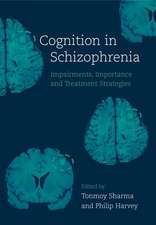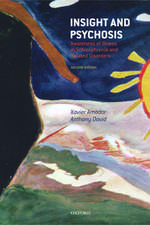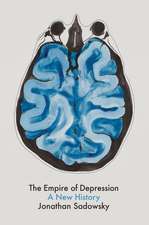The Madness of Fear: A History of Catatonia
Autor Edward Shorter, Max Finken Limba Engleză Paperback – 16 aug 2018
Preț: 323.79 lei
Preț vechi: 401.89 lei
-19% Nou
Puncte Express: 486
Preț estimativ în valută:
61.97€ • 64.20$ • 51.71£
61.97€ • 64.20$ • 51.71£
Carte tipărită la comandă
Livrare economică 11-17 martie
Preluare comenzi: 021 569.72.76
Specificații
ISBN-13: 9780190881191
ISBN-10: 0190881194
Pagini: 224
Dimensiuni: 155 x 231 x 13 mm
Greutate: 0.32 kg
Editura: Oxford University Press
Colecția OUP USA
Locul publicării:New York, United States
ISBN-10: 0190881194
Pagini: 224
Dimensiuni: 155 x 231 x 13 mm
Greutate: 0.32 kg
Editura: Oxford University Press
Colecția OUP USA
Locul publicării:New York, United States
Recenzii
I am extremely grateful for the very wise decision of Shorter and Fink to collaborate...I am convinced Shorter and Fink's book will become a classic.
Shorter and Fink offer a probing, well-informed, and very readable account of the arcane theorizing and factional struggles by which psychiatrists hashed out a consensus on catatonia, schizophrenia, and other psychic ailments, one that's enriched with dozens of intriguing case studies ... The result is an engrossing portrait of a fearsome and fascinating disease, and a searching inquiry into the ways in which doctors misunderstand the mind."
One expects to read a history book. But The Madness of Fear is so much more than that. [It] is an impressive piece of work that should be on the shelf of each psychiatrist... Shorter and Fink succeed in braiding the historic bits and pieces together to create a story that reads like a novel. An exciting one!
Shorter and Fink offer a probing, well-informed, and very readable account of the arcane theorizing and factional struggles by which psychiatrists hashed out a consensus on catatonia, schizophrenia, and other psychic ailments, one that's enriched with dozens of intriguing case studies ... The result is an engrossing portrait of a fearsome and fascinating disease, and a searching inquiry into the ways in which doctors misunderstand the mind."
One expects to read a history book. But The Madness of Fear is so much more than that. [It] is an impressive piece of work that should be on the shelf of each psychiatrist... Shorter and Fink succeed in braiding the historic bits and pieces together to create a story that reads like a novel. An exciting one!
Notă biografică
Edward Shorter, PhD, FRSCAfter receiving a PhD from Harvard University in 1968, Dr Shorter took up a History appointment at the University of Toronto, where he became the Jason A Hannah Professor of the History of Medicine in 1991. Shorter, who teaches in the Faculty of Medicine and is a member of the Department of Psychiatry, has written numerous books, including a History of Psychiatry (Wylie 1996) and How Everyone Became Depressed (Oxford UP, 2013).Max Fink, MDAfter receiving an M.D. from the New York University School of Medicine in 1945, Dr. Fink qualified in neurology, psychiatry and psychoanalysis. Began a life-time research career on the practice and mechanisms of convulsive therapy (electroshock). Interest in new psychoactive agents led to digital computer analysis of drug effects laying the foundation for the science of pharmaco-EEG. Interest in the syndromes of catatonia and melancholia began in 1977 leading to texts and histories of both syndromes.






















